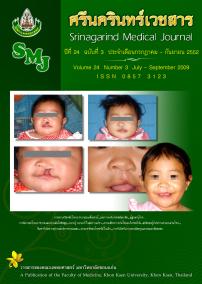ThaiScience
ThaiScience
SRINAGARIND MEDICAL JOURNAL
Volume 35, No. 06, Month NOVEMBER, Year 2020, Pages 720 - 725
Multiplex pcr for identifying bcr-abl fusion transcript types in northeastern thailand chronic myeloid leukemia patients
Kanokon Chootawiriyasakul, Kanchana Chansung
Abstract Download PDF
Background and Objective: Philadelphia chromosome is the chromosome originating from the reciprocal translocation between long arms of chromosome 9 and chromosome 22 t (9;22) (q34; q11), it presents in 90 - 95% of patients with chronic myeloid leukemia. The aberration results from a reciprocal translocation are creating a BCR-ABL fusion gene. There are two major forms of the BCR-ABL fusion gene, involving ABL exon 2, but including different exons of BCR gene. The transcript b3a2 and b2a2 codes for a p210 protein. Other fusion gene leads to the expression of an e1a2 transcript, which codes for a p190 protein. Its frequency varies in different populations but there are no data from northeastern Thailand. In this study we aimed to report BCR-ABL fusion transcript types in northeastern Thailand CML patients by Multiple Reverse Transcriptase-Polymerase Chain Reaction (Multiplex PCR). Materials and Methods Retrospective descriptive and analytical study of all adult CML patients in Srinagarind and Khon Kaen hospitals, which is the main tertiary medical center in the northeastern region Thailand. Data has been collected from medical records for 3 years (January 2017 to January 2020). Peripheral blood or bone marrow samples were analyzed by multiplex PCR from 177 adult northeastern Thailand CML patients. Aim to identify BCR-ABL fusion transcript types in northeastern Thailand CML patients. Multiplex PCR. Results: All patients examined were positive for some type of BCR/ABL rearrangement. The majority of the patients (93.79%) expressed one of the p210 BCR-ABL transcripts, b3a2 and b2a2 transcript types were detected in 58.19% and 35.59% respectively. Co-expression of b3a2 (p210)/e1a2 (p230) was detected in 0.56%. The expression of an e1a2 transcript type, which codes for a p190 protein showed 4.52%. And 1.14% was detected in e19a2 transcript type. Co-expression of p210/p190 was not detected. Conclusions: Multiplex RT-PCR is useful and saves time in the detection of BCR-ABL fusion transcript types; the occurrence of these transcripts associated with CML can assist in prognosis and treatment of disease.
Keywords
Multiplex PCR, BCR-ABL Fusion Transcript Types, Chronic Myeloid Leukemia (CML).SRINAGARIND MEDICAL JOURNAL
Published by : Faculty of Medicine, Khon Kaen University
Contributions welcome at : http://www.smj.ejnal.com/e-journal/journal/index.php
